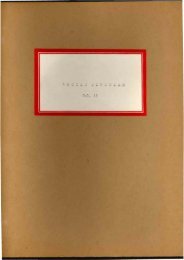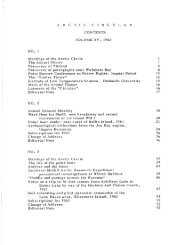Volume 4, 1951 - The Arctic Circle - Home
Volume 4, 1951 - The Arctic Circle - Home
Volume 4, 1951 - The Arctic Circle - Home
You also want an ePaper? Increase the reach of your titles
YUMPU automatically turns print PDFs into web optimized ePapers that Google loves.
York boats, pointed at both ends like a canoe, and of<br />
.8hallow draught, were the answer to a demand for a type of<br />
boat light enough to be taken on rollers over the many inand<br />
portages, seaworthy enough to navigate large bodies of<br />
ter such as Lake Winnipeg, and commodious enough to carry<br />
heavy cargo of furs, together with a crew of eight or nine<br />
voyageurs. <strong>The</strong> boat was steered by a foreman standing in<br />
·thestern, sweep in hand, and chanting out the rhythm for<br />
the crew, each of whom managed a single, heavy sweep, bracing<br />
·h1sfeet and rising from his seat during the course of each<br />
power stroke. <strong>The</strong>re was much rivalry, good-natured and other-<br />
1ae, among the members of York boats when travelling in<br />
convoy. Crews of the first boats to arrive at portages would<br />
normally work together to get the boats over, but it often<br />
happened that the crew of the last boat was left to shift<br />
tor itself. <strong>The</strong> voyageurs were picked for their toughness,<br />
but the work was killing, the customary portage load was<br />
'twohundred pounds, the rations consisted of flour, lard,<br />
;andtea, and the men were more often .soaked to the skin than<br />
~. <strong>The</strong> useful life of a boatman was short, but carried a<br />
definite prestige during that time.<br />
It was in York boats that Lord Selkirk's Irish<br />
oolonists, in 1812, travelled from York Factory to Norway<br />
Bouse and down Lake Winnipeg, to found Red River Settlement.<br />
Borway House receives its name from a group of Norwegians<br />
oommissioned to build a "winter road" between there and York<br />
lactory. <strong>The</strong>y later received help from colonists driven<br />
trom the settlement by the massacre at Seven Oaks in 1816,<br />
but the road did not prove feas ible, and no traces remain<br />
ot Swampy Lake House, a former supply de pot on Swampy Lake,<br />
or of Rock Lake House, at the first of the rapids encountered<br />
on the trip inlando York Factory itse1f is n~N merely a<br />
distribution point for a few small stations sorne hundred<br />
miles distant.<br />
<strong>The</strong> first botanical collections along the Hayes-<br />
Eohimamish route were made by John Richardson, a member of<br />
l.ranklin's overland expeditions of 1819-22 and 1825-27.<br />
Also with Franklin was George Back, who used the route during<br />
the return trip of his 1833-35 expedition in search of John<br />
Ross. ln 1845, John Rae, who later discovered relies of<br />
f.ranklin's ill-fated third expedition, travelled down the<br />
Hayes to York Factory, and made a collection of plants<br />
between there and Churchill. <strong>The</strong> most recent collection of<br />
,plants made along the route before the writer's 1949 expe-<br />
4it1on is apparently that of Robert Bell, who, in 1880, made<br />
a geological survey of the country b8tv:scm Lake Winnipeg and<br />
Hudson Bay n <strong>The</strong> plants were d6ts:~illinedby John Macoun, the<br />
tirst botanist of the Geolog~cal Survey of Canada, and founder<br />
of the National He:rbs.T ':"um~












